Rover Thomas & Kimberley Ochre Walk Through
David Wroth from Japingka Gallery talks about some of the works from the Rover Thomas & Kimberley Ochre Painters exhibition.
It's a wonderful experience to see a group of paintings by famous, now deceased artists. We are in the East Kimberley with collections from some of the really great names from Turkey Creek/ Warmun community. Artists like Jack Britten and Rover Thomas, Queenie McKenzie and Freddie Timms, and the slightly more contemporary Shirley Purdie.
It's a great thrill for us to have such a range of work by an artist like Jack Britten, who has six works in the show. Many of the works were painted around 15 years ago, and a few are even older. These are Jack Britten's incredible interpretations of the country around the Bungle Bungles, or Purnululu, with his trademark designs. We notice the banded structures of the domed hills at Purnululu, and he uses body markings that are familiar from ceremonial performances by Gija people. He puts those body markings onto the landscape and this makes a very distinctive structure within his designs.
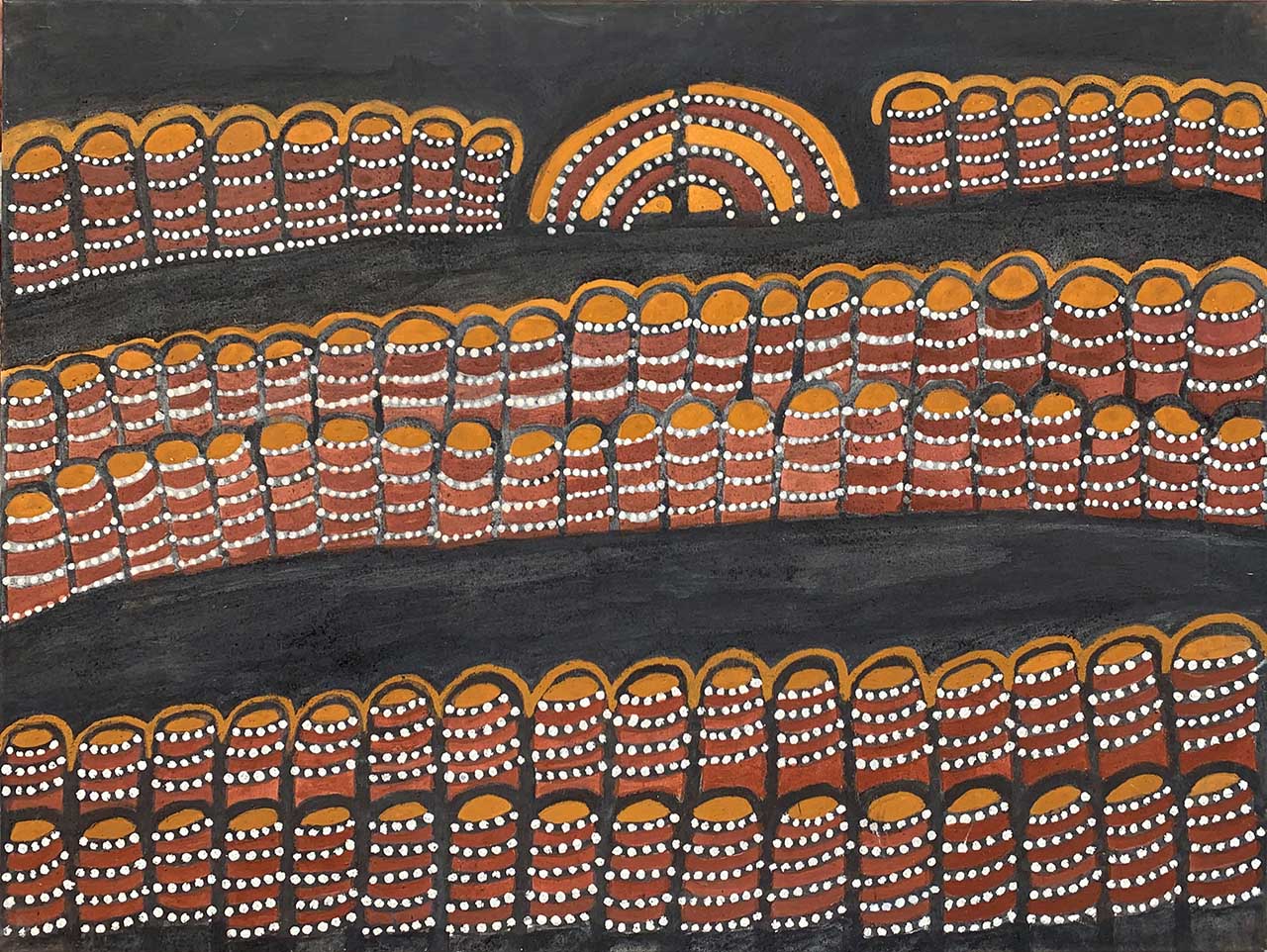
The style of the East Kimberley Warmun paintings like those of Jack Britten tend to be more of a landscape format, in the sense that they read from top to bottom in the picture plane. So there is something in the foreground and something in the background, but it's very much placed in two dimensions. You see one section above the other, like a landscape that you know and you can go into the further regions of, into a distance that you know exists further away.
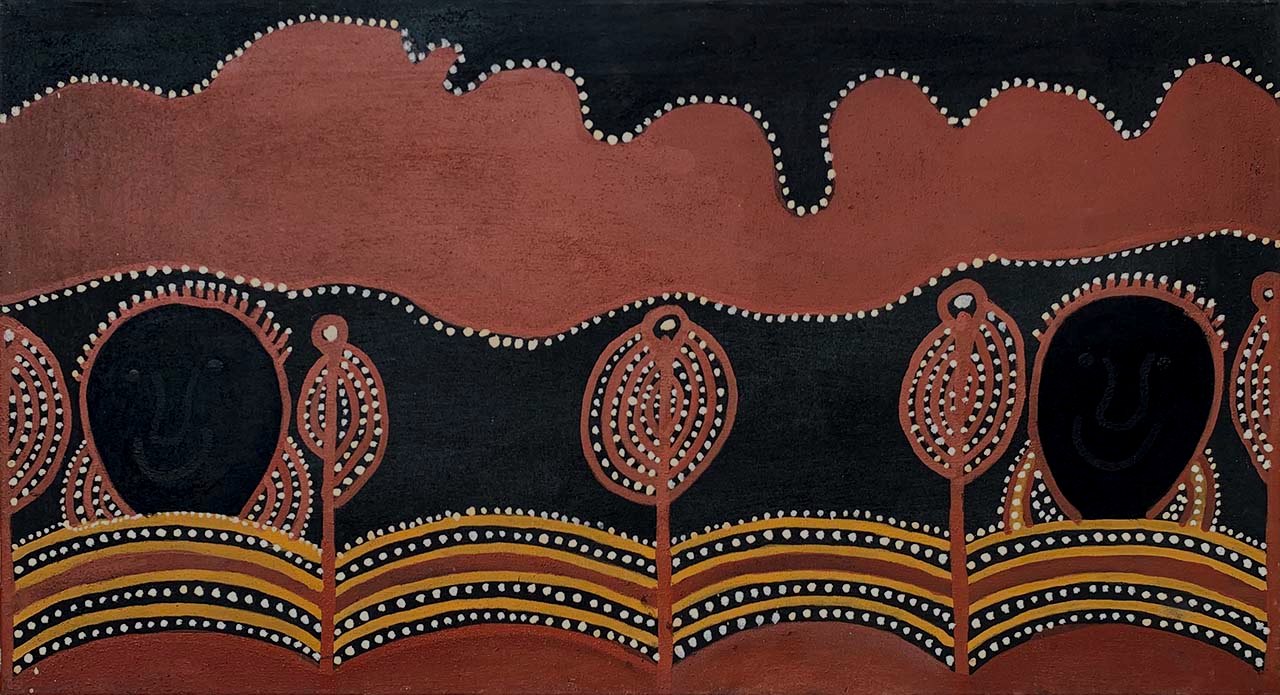
This next painting on the wall by Jack Britten is Milliwiny Springs. As many of these older painters were stockman during their working lives, so they have great familiarity with parts of the country where they worked cattle and rode horses. They truly know this country, and they carry mental maps and images of what is significant in that country and something of the Creation story that is integral to it.
Jack's paintings are full of markings. They're full of demarcation lines with dotted borders and references to particular Creation stories and events that happened, both historical and from Ngarrarngkarni or the Dreaming period.
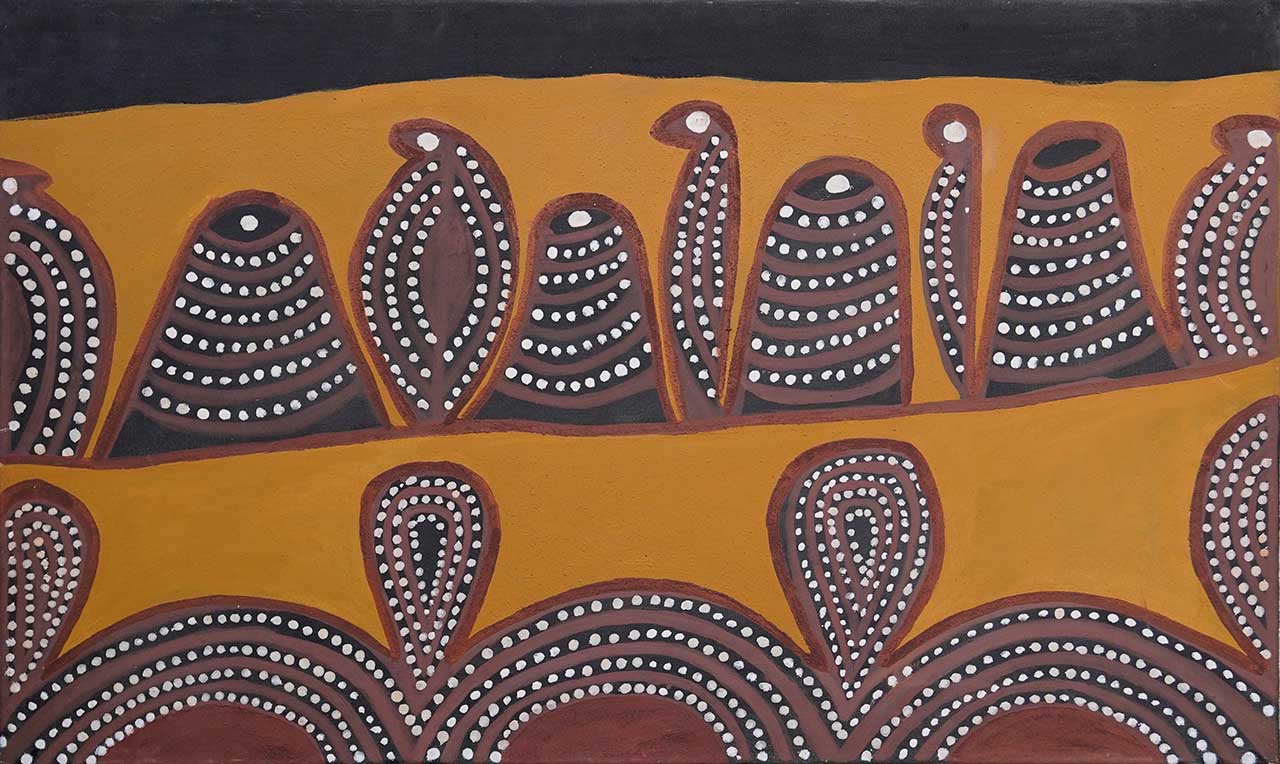
This third painting of Jack's is different again. He's placed images of herons that are interspersed between the domed rocks of Purnululu. He's taken something of the natural environment, the birdlife, and put a totemic image of the herons in amongst the domed hills. There's the quintessential Aboriginal story of the animals rising up out of Country and their totems rising out of Country. Everything is locked into the location where the Creation story takes place.
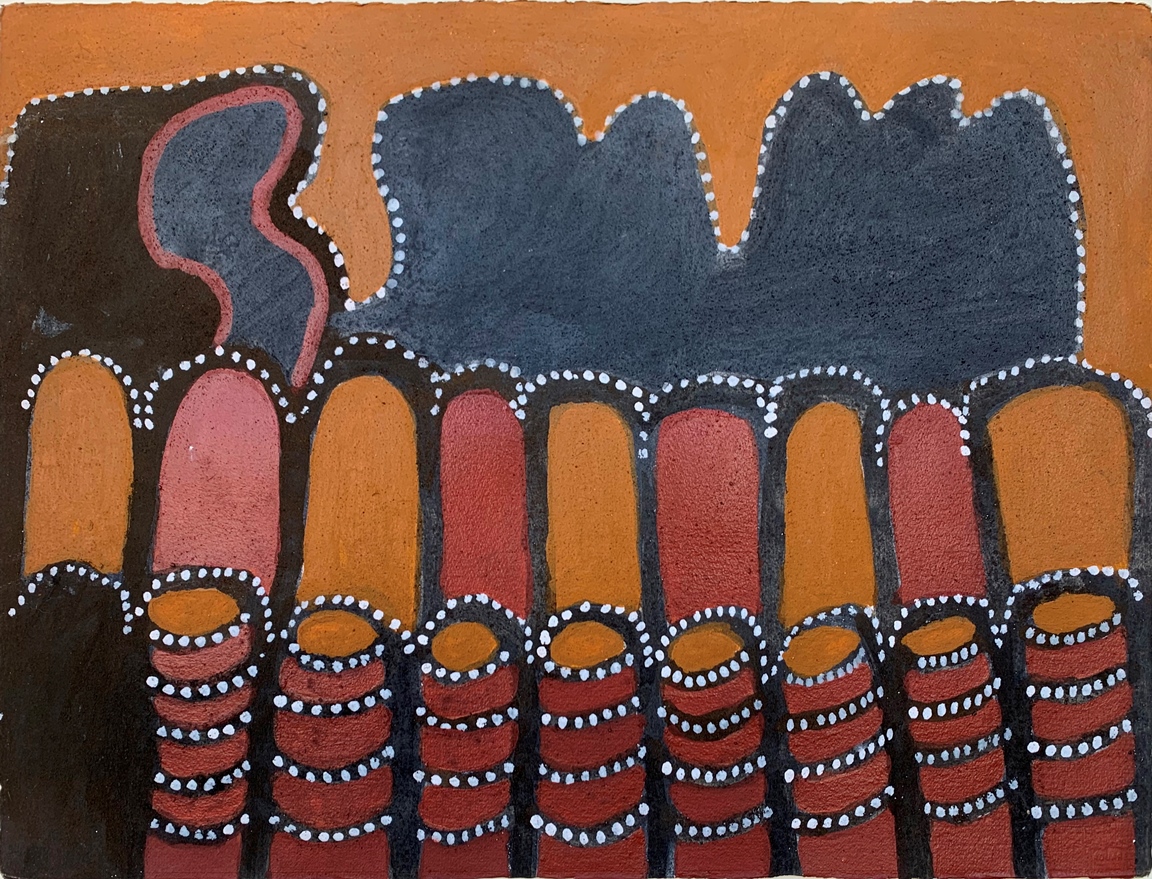
Next is Jack's painting of Yalatji Country. This painting is made using ochre on paper. Just about everything else in the exhibition is ochre on canvas, with several boards from Rover Thomas being ochre on plywood or ochre on wood panel. The painting is a really heavily constructed image of the Bungle Bungles and a beautiful little work. A really powerful painting.
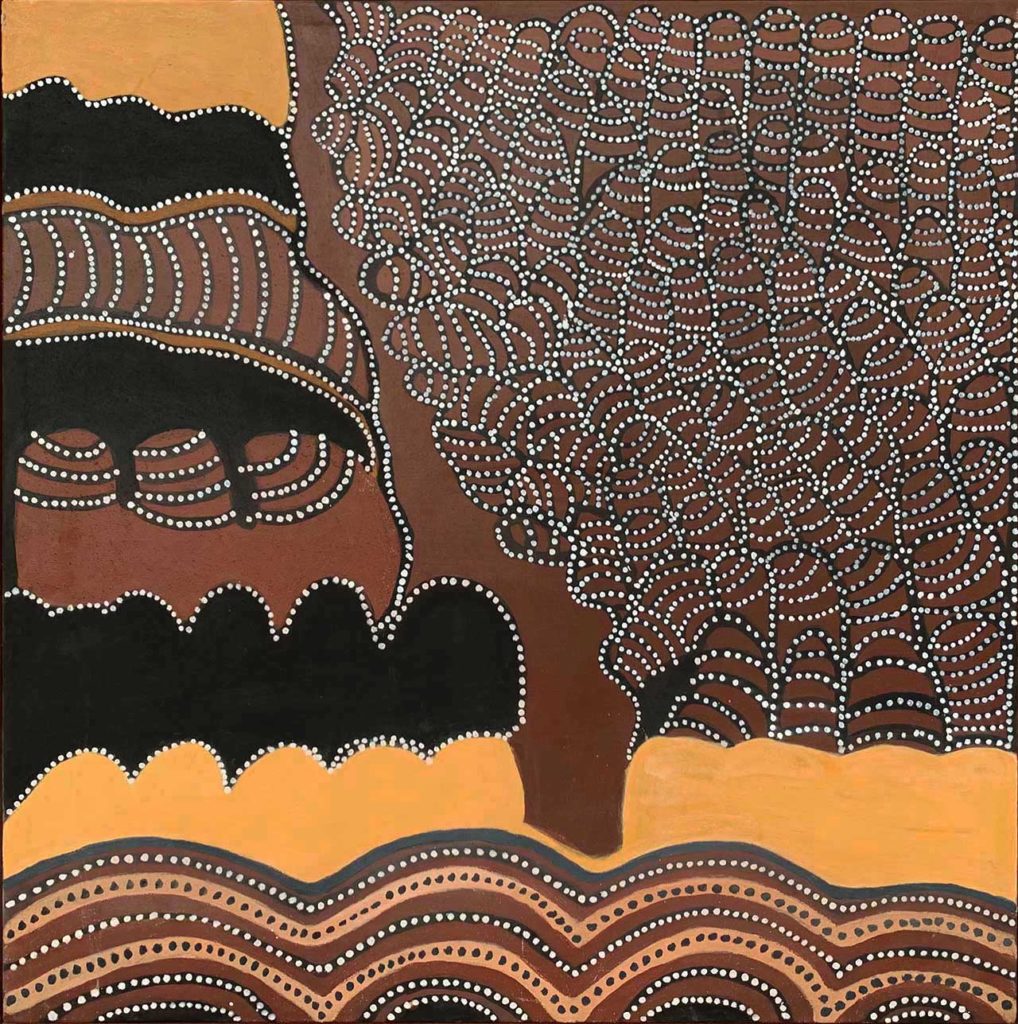
The largest of Jack Britten's paintings in the show is titled Goodi-Goodi,. This painting, 1.2 metres square, shows the way the Bungle Bungle landscape comes together as viewed from above. We can see riverbeds running through it and open areas of sand. It's quite maze-like and the rock formations form into solid blocks that are very difficult to navigate. Through them, if you know where you're going, there are small openings, almost like passageways through the rocks, that are formed by old riverbeds. They're often just beds of sand that allow you to get through the country that otherwise forms a visual barrier. These passages take you deep into the extraordinary landscape that is a historically ancient seabed material that's been deposited, and hence the layers of colour and sediment have built up the extraordinary stratas which have then been eroded back into these dome-shaped hills.
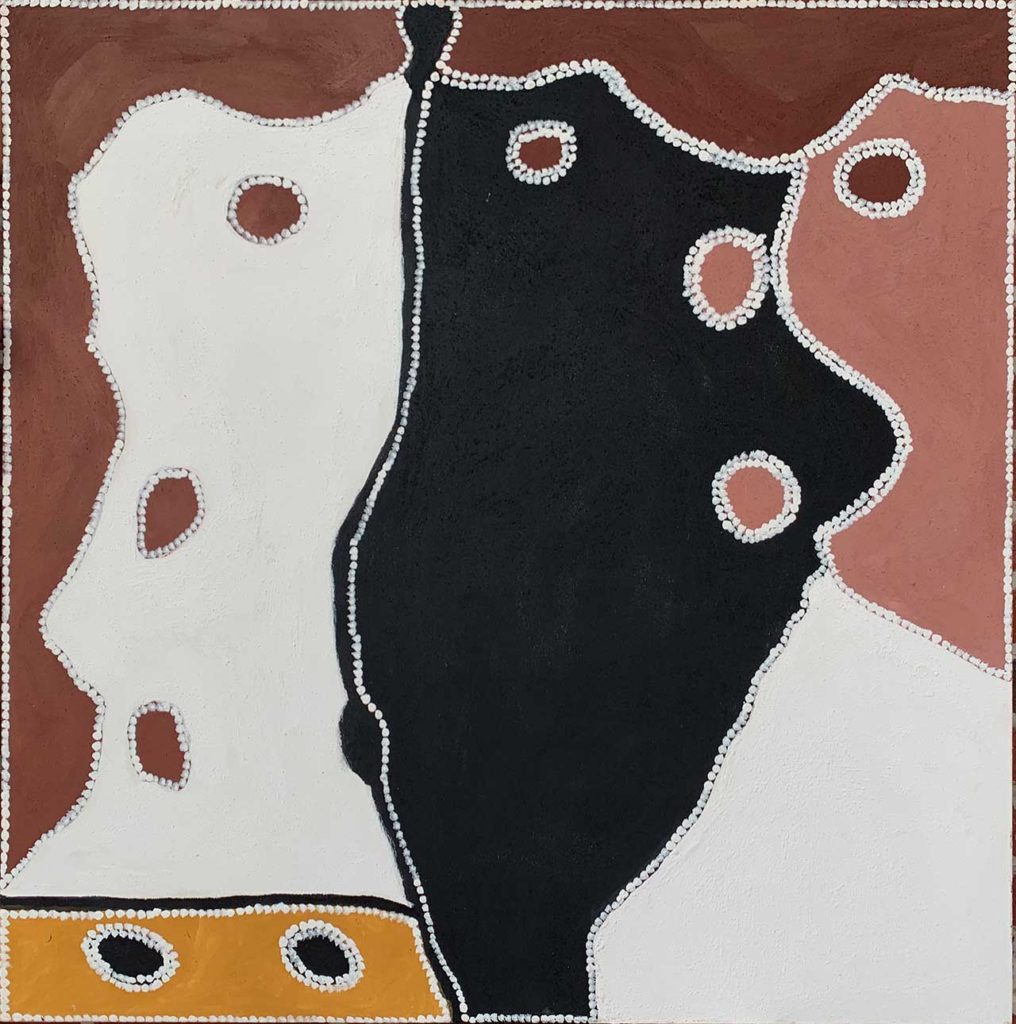
Freddie Timms is a classic artist-stockman. In other words he remembers the country in terms of the type of soil and the type of country it is when you traverse it on horseback. His works are very geometric and very flat terrain images of country, remembered in the form of a map, and showing black soil country and waterholes and places where stock were able to be mustered. They become very elegant paintings of the Kimberley. In that way they are more abstracted images than in the work of an artist like Jack Britten, but this is a very elegant little painting.
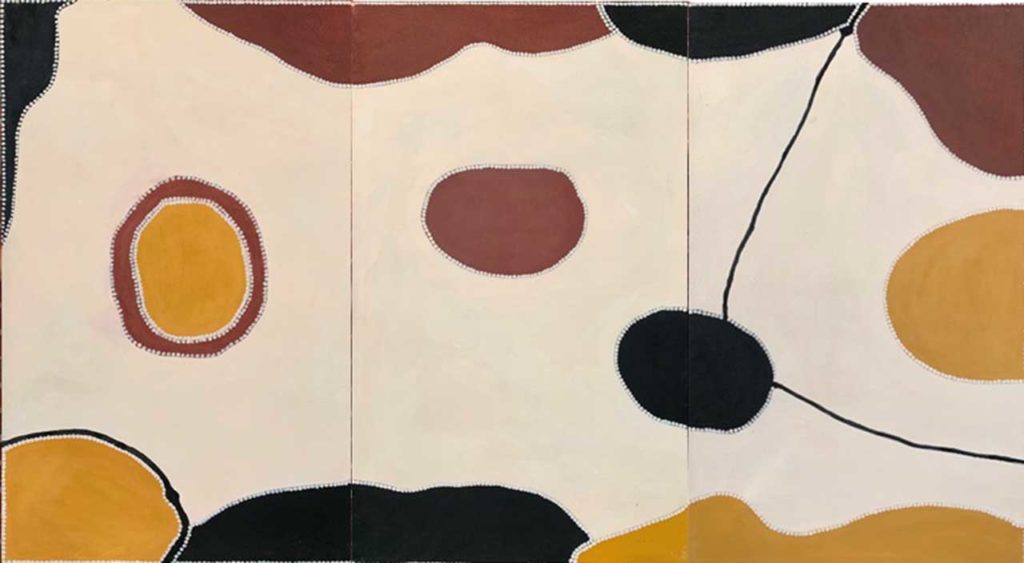
This is a large painting by Freddie Timms, 2.7 meters across. It's a triptych. It has those flowing rounded shapes that are typical of Freddie Timms work, plus a big open spatial area in which the shapes float. In this case the background is a slightly pinkish-white colour. These are very warm tones, very soft ochre painting on three canvas panels. This is a major painting, quite a sensational piece of work, and a classic image of Kimberley country by a great Kimberley artist.

Now we're standing in front of two small paintings by the great female artist Queenie McKenzie. Queenie looked at the work of the male artists and declared that she could produce artworks of her own - she went on to be the first great woman artist amongst the Gija painters at Turkey Creek. The exhibition includes two extraordinary little paintings by her. Queenie was known for using softer tones in her ochre paintings. Her work shows the big edifice hills and ranges that are typical of the Kimberley, Queenie will mark them up in pinks and soft toffee colours, which are beautifully delineated with a grey background.
Queenie often tells the stories that took place on country. She would tell massacre stories and other stories of life of Aboriginal people working on the cattle stations during quite difficult times. She was an older woman, perhaps in her late 70s when she paintied these stories.
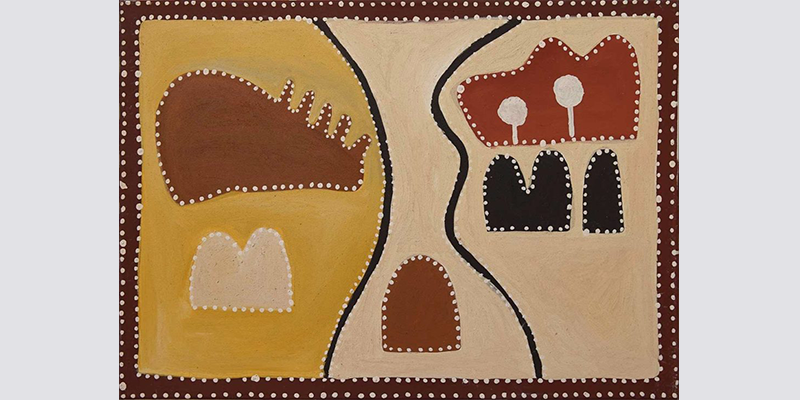
Queenie quite particularly locates her paintings in specific parts of her country, often Texas Downs and adjacent cattle stations where Gija Aboriginal people spent all their lives. There will be ranges of hills and locations marked by trees and dry riverbeds. And the creation stories, the Ngarrarngkarni stories, that created these landscapes and have continued to be locations where stories take place for this community. Events happen, people live in and around these spaces, it's all an integrated part of the life of Aboriginal people from this country.
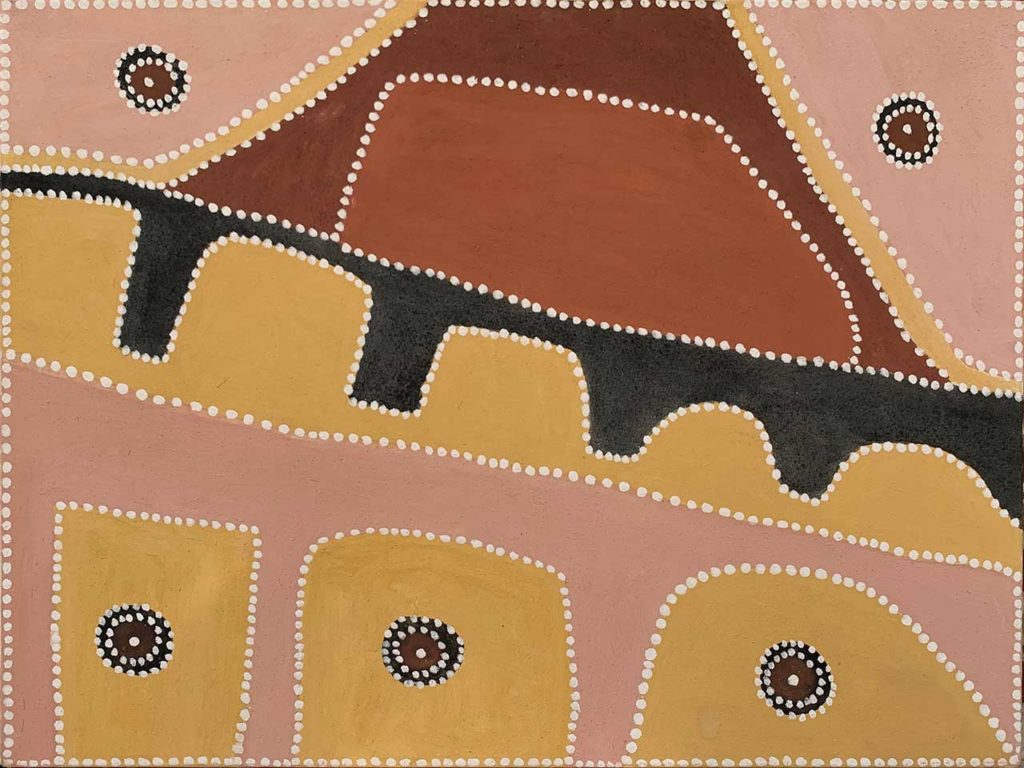
Now next to the two Queenie paintings is one by Henry Wambini, another one of the established older group of artists. This is an unusual work which has taken the very soft pastel tones of ochre paint into his painting of Hann Spring country. It is the most gentle painting. Henry Wambini was a very gentle man in his own right, and he's created a beautiful work in pinks and cream colours. It's a very accepting vision of the Kimberley, because the Kimberley really can be quite a harsh frontier environment. He's included those distinctive shapes of the hills and the ranges that mark all that country of the East Kimberley. This is a beautiful painting.
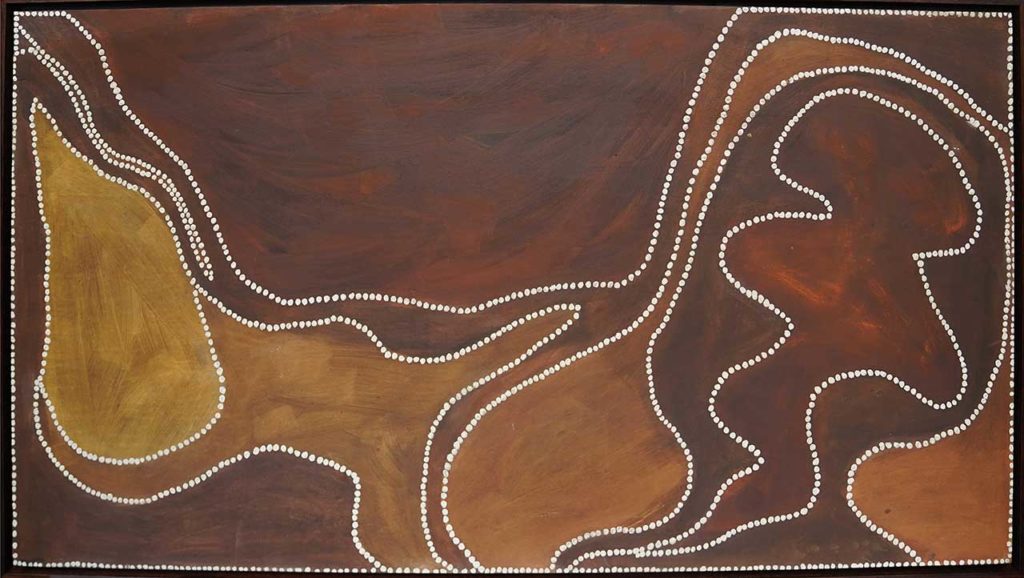
Now we walk up to a wall that has four Rover Thomas paintings all from the period of the 1980s. The largest one, Bedford Station, shows Rover's distinctive method of washing and brushing layers of ochre to create big spaces, sometimes semi-transparent or showing the colours underneath. The forms are delineated with the rows of white dots that are typical of all the Warmun painters. But these works they are warm, they are full of movement, and with the extraordinary range of tonal values that Rover brings to his paintings.
This is a wall of extraordinary paintings, they have never been shown in a gallery before. So to be able to walk past and enjoy four Rover Thomas paintings is such a great thrill for us.
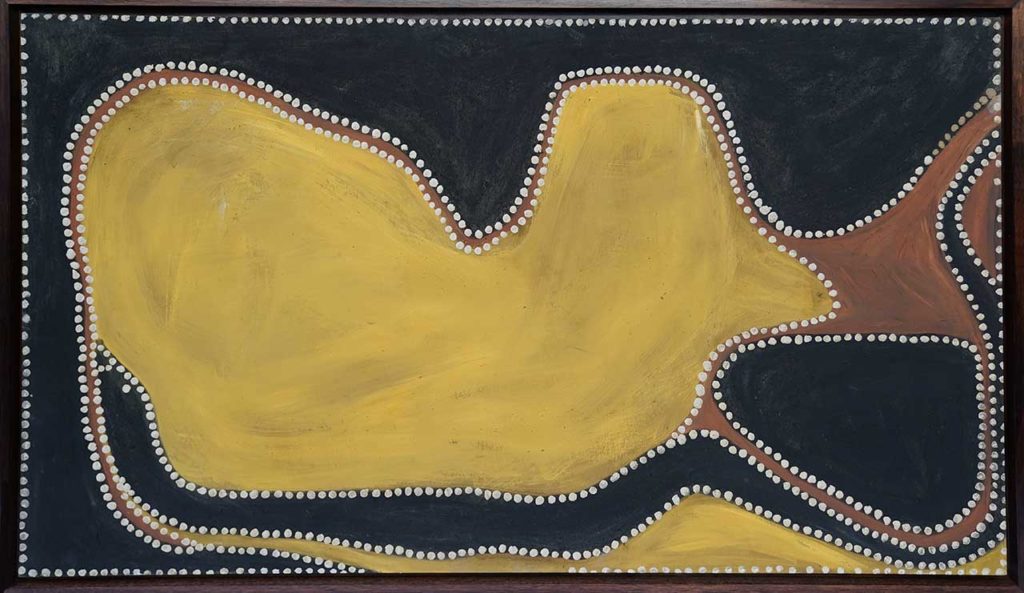
This painting, Lingurr, by Rover Thomas is one of those classic images where the landscape and the Creation story, the water spirit, are embedded into a unified design. We have the black shape of the snake passing through the landscape as though coming from one waterhole. The Creation snake is such a powerful Creation story within Aboriginal communities. Rover is using the black colour for the outer regions of the painting and for the snake and in the encircled waterhole or ceremonial space. By linking them all with the one colour the artist ensures that no one part of the story stands out from the other. It all feels like it ties together - sometimes you look and you notice the snake shape winding through the landscape. That's Rover talking about his country and the powerful forces that created it.
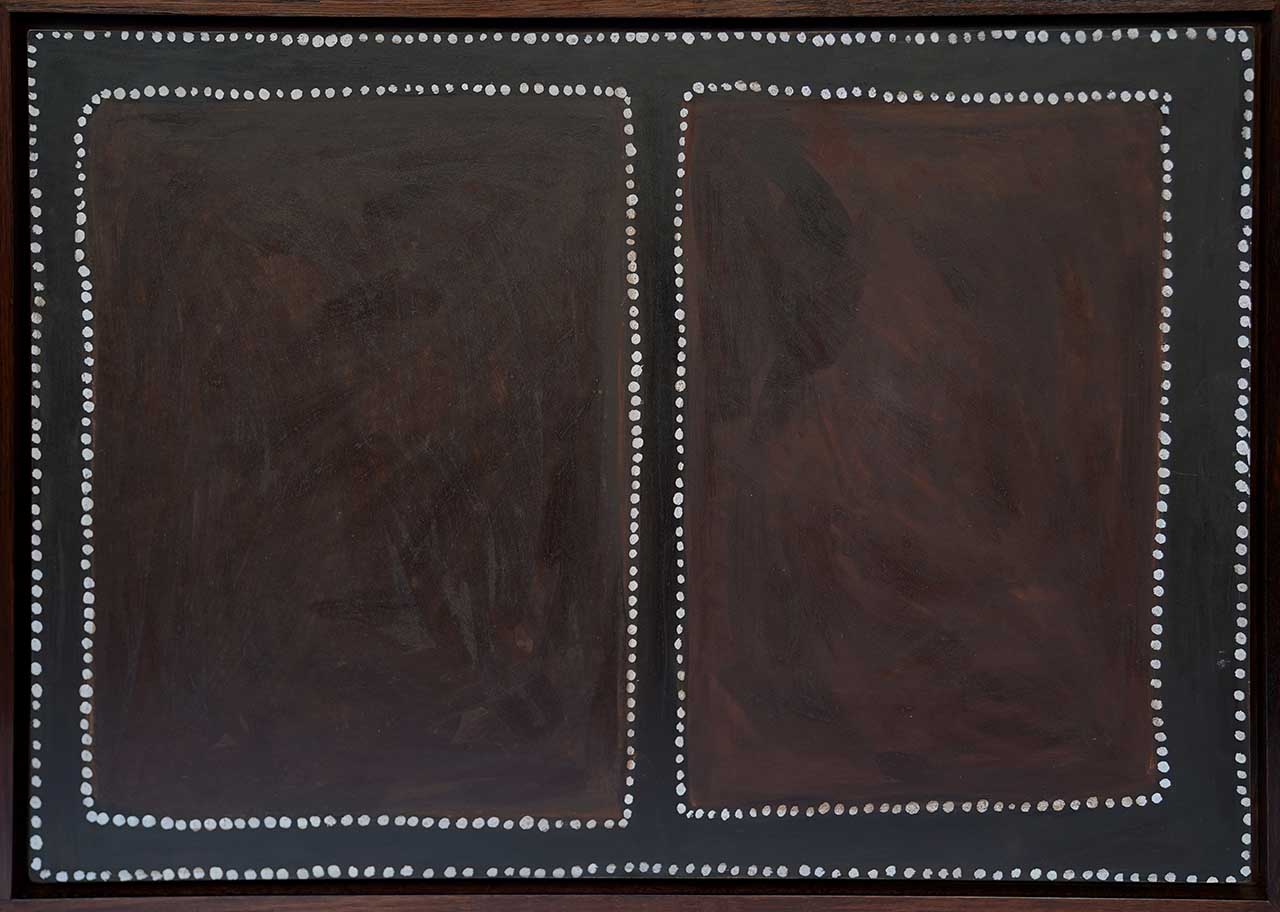
Perhaps the simplest painting in the whole show is Rover's painting of Wati Kutjara. This is one of the great Men's Creation stories. These ancestor figures travelled over huge parts of the continent, and their journey led to the creation of major aspects of the landscape. These Ancestors are central to Creation stories in Aboriginal communities right across the country. Rover has made this story, simply the two rectangles of dark brown textured paint, and then delineated these with black areas that separate the whole painting from the border and divide up the two rectangles. It's an incredibly simple image but represents a powerful force, Wati Kutjara.
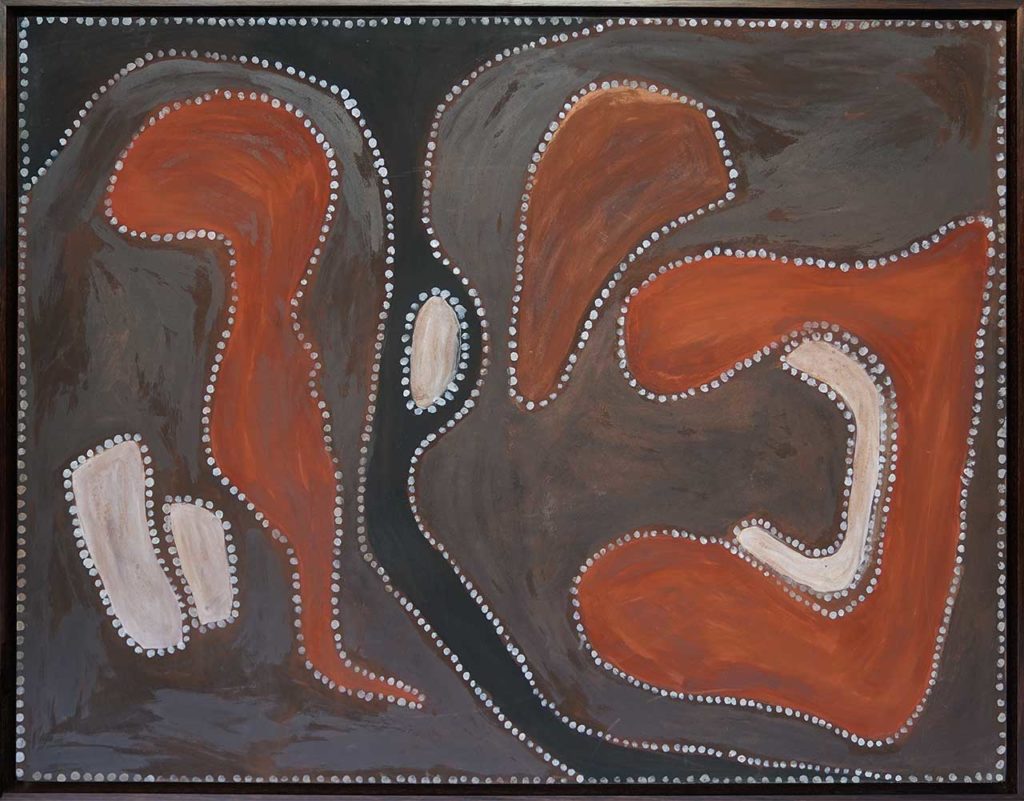
Here is another painting by Rover with the title Bedford Station. This refers to locations on the station that are incredibly meaningful to Gija people who work there. In many ways these hills and caves are the secret locations on this Kimberley cattle station. All are very important places for Aboriginal people. They are areas where very few people get to, where Aboriginal people have used for times of solitude and danger and hiding away. These are seen as important refuges in the landscape for traditional owners.
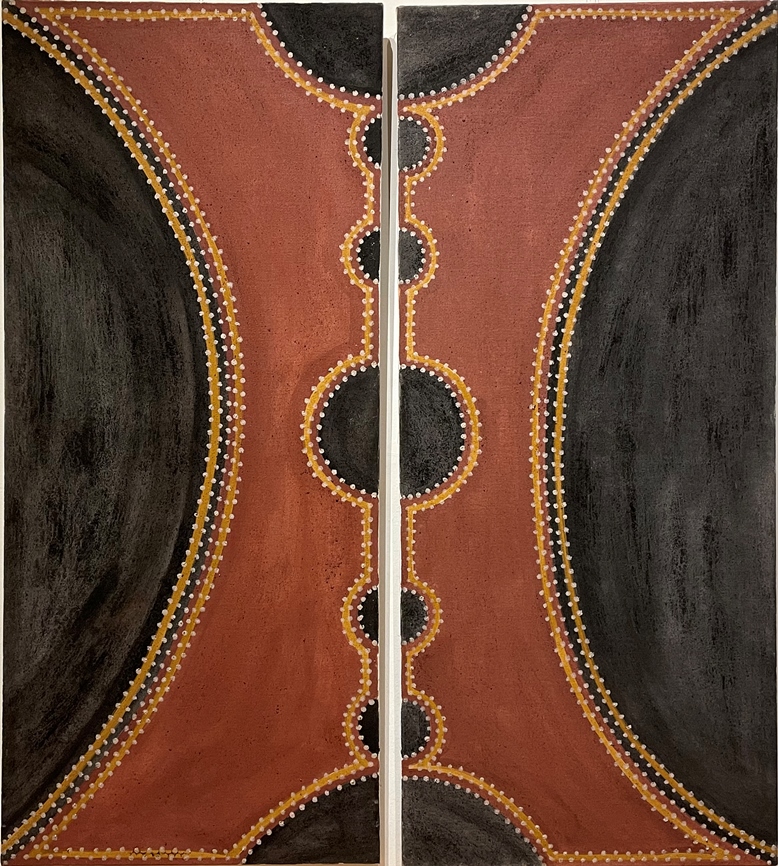
Charlene Carrington is easily the youngest artist, and the third woman artist in the show. So we have Shirley Purdie and Queenie McKenzie, and here is Charlene Carrington. She has created a most extraordinary painting called Texas Rockhole. Now this painting works in two different directions. We actually had to decide which way to present it. So it's a diptych, with a number of little rockholes running vertically down, and they meet up where the two canvases join. But you can also hang the painting so that the large oval shaped rockhole on the outside actually join as twp parts together, and it becomes a very different continuous painting. It could have had a third panel, which would have allowed you to have seen both aspects. This is like one of those trick paintings where you can put it one way and what you get is the small rock holes, and then you can move it the other way and you get the enormous dark rock hole at the centre.
It's a beautiful painting. I really also like it as a horizontal painting in two sections, so it's like a landscape. This is a jigsaw painting. I think you get three different paintings with this work, depending on how you present it. And they're all quite extraordinary in composition. The way it all comes together is a marvellous visual treat.
